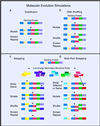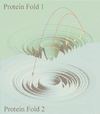A hierarchical approach to protein molecular evolution
- PMID: 10077554
- PMCID: PMC15812
- DOI: 10.1073/pnas.96.6.2591
A hierarchical approach to protein molecular evolution
Abstract
Biological diversity has evolved despite the essentially infinite complexity of protein sequence space. We present a hierarchical approach to the efficient searching of this space and quantify the evolutionary potential of our approach with Monte Carlo simulations. These simulations demonstrate that nonhomologous juxtaposition of encoded structure is the rate-limiting step in the production of new tertiary protein folds. Nonhomologous "swapping" of low-energy secondary structures increased the binding constant of a simulated protein by approximately 10(7) relative to base substitution alone. Applications of our approach include the generation of new protein folds and modeling the molecular evolution of disease.
Figures


Similar articles
-
The Role of Evolutionary Selection in the Dynamics of Protein Structure Evolution.Biophys J. 2017 Apr 11;112(7):1350-1365. doi: 10.1016/j.bpj.2017.02.029. Biophys J. 2017. PMID: 28402878 Free PMC article.
-
Conformation-dependent sequence design: evolutionary approach.Eur Phys J E Soft Matter. 2004 Jan;13(1):15-25. doi: 10.1140/epje/e2004-00036-1. Eur Phys J E Soft Matter. 2004. PMID: 15024612
-
Neutrality and evolvability of designed protein sequences.Phys Rev E Stat Nonlin Soft Matter Phys. 2010 Jul;82(1 Pt 1):011906. doi: 10.1103/PhysRevE.82.011906. Epub 2010 Jul 12. Phys Rev E Stat Nonlin Soft Matter Phys. 2010. PMID: 20866647
-
Simulating protein evolution in sequence and structure space.Curr Opin Struct Biol. 2004 Apr;14(2):202-7. doi: 10.1016/j.sbi.2004.03.001. Curr Opin Struct Biol. 2004. PMID: 15093835 Review.
-
Evolutionary transitions in protein fold space.Curr Opin Struct Biol. 2007 Jun;17(3):354-61. doi: 10.1016/j.sbi.2007.06.002. Epub 2007 Jun 18. Curr Opin Struct Biol. 2007. PMID: 17580115 Review.
Cited by
-
Consequences of Genetic Recombination on Protein Folding Stability.J Mol Evol. 2023 Feb;91(1):33-45. doi: 10.1007/s00239-022-10080-2. Epub 2022 Dec 3. J Mol Evol. 2023. PMID: 36463317 Free PMC article.
-
Evolution and evolvability of proteins in the laboratory.Proc Natl Acad Sci U S A. 2004 Mar 23;101(12):3997-8. doi: 10.1073/pnas.0400475101. Epub 2004 Mar 15. Proc Natl Acad Sci U S A. 2004. PMID: 15024102 Free PMC article. No abstract available.
-
Chimeric genes as a source of rapid evolution in Drosophila melanogaster.Mol Biol Evol. 2012 Feb;29(2):517-29. doi: 10.1093/molbev/msr184. Epub 2011 Jul 18. Mol Biol Evol. 2012. PMID: 21771717 Free PMC article.
-
Re-engineering a beta-lactamase using prototype peptides from a library of local structural motifs.Protein Sci. 2009 Feb;18(2):440-9. doi: 10.1002/pro.47. Protein Sci. 2009. PMID: 19165724 Free PMC article.
-
Theoretical aspects of immunity.Annu Rev Chem Biomol Eng. 2010;1:247-76. doi: 10.1146/annurev-chembioeng-073009-100952. Annu Rev Chem Biomol Eng. 2010. PMID: 22432581 Free PMC article. Review.
References
MeSH terms
Substances
LinkOut - more resources
Full Text Sources
Other Literature Sources

